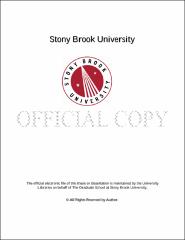| dc.identifier.uri | http://hdl.handle.net/11401/76923 | |
| dc.description.sponsorship | This work is sponsored by the Stony Brook University Graduate School in compliance with the requirements for completion of degree. | en_US |
| dc.format | Monograph | |
| dc.format.medium | Electronic Resource | en_US |
| dc.language.iso | en_US | |
| dc.publisher | The Graduate School, Stony Brook University: Stony Brook, NY. | |
| dc.type | Thesis | |
| dcterms.abstract | Candida albicans is the most important human pathogenic fungus. Due to rising rates of infection and limited treatment options, it has become increasingly vital to identify the structures of the cell wall (CW) that can serve as ligands for anti-fungal drug recognition. Recently, a number of studies have focused their attention to the outer portion of the CW, which is comprised of glycoproteins modified with asparagine (N)-linked or serine or threonine (O)-linked mannan. Current models have shown N-linked mannan to be one of the key structures responsible for immune-cell recognition. Mutations in construction of the N-linked mannan outer chain, which is comprised of ~200 mannose units, have been hypothesized to lack ligands that would otherwise be recognized by macrophages [38]. Here I performed experiments toward testing the role of mannan in immune cell recognition, by constructing C. albicans mutants that are predicted to lack these structures. The S. cerevisiae mnn10 and mnn11 mutants are defective in the α -1,6-mannosyltransferases that build the backbone of the mannan outer chain. Furthermore, recent literature that describes various other components of the CW that have potential roles in macrophage recognition are also studied. I have also constructed plasmids to knockout MNN11 in Candida albicans. The MNN10 and MNN11 genes are primarily responsible for α -1,6-linked mannose polymerizing activity of the outer chain in S. cerevisiae and several other yeast species [4,5]. Earlier studies in S. cerevisiae concluded that mnn10 mutants contain N-linked oligosaccharide chains of approximately 6-16 mannose units, comparatively shorter than the average 50 units that are found in wild type (WT) strains of Saccharomyces cerevisiae [5]. To test the model that these mutants are lacking a critical components of the N-linked mannan ligand for immune recognition of C. albicans, we constructed C. albicans strains deleted for MNN10 and its homologous gene MNN11. Future analyses of these C. albicans mannosyltransferase mutant strains in mice may provide insight into development of more specific anti-fungal therapies. | |
| dcterms.available | 2017-09-20T16:51:26Z | |
| dcterms.contributor | Dean, Neta | en_US |
| dcterms.contributor | Konopka, James. | en_US |
| dcterms.contributor | Konopka, James | en_US |
| dcterms.creator | Mindlin, Frank August | |
| dcterms.dateAccepted | 2017-09-20T16:51:26Z | |
| dcterms.dateSubmitted | 2017-09-20T16:51:26Z | |
| dcterms.description | Department of Biochemistry and Cell Biology. | en_US |
| dcterms.extent | 52 pg. | en_US |
| dcterms.format | Application/PDF | en_US |
| dcterms.format | Monograph | |
| dcterms.identifier | http://hdl.handle.net/11401/76923 | |
| dcterms.issued | 2014-12-01 | |
| dcterms.language | en_US | |
| dcterms.provenance | Made available in DSpace on 2017-09-20T16:51:26Z (GMT). No. of bitstreams: 1
Mindlin_grad.sunysb_0771M_12180.pdf: 818159 bytes, checksum: 10ad25d53f21c367668552f204344ab1 (MD5)
Previous issue date: 1 | en |
| dcterms.publisher | The Graduate School, Stony Brook University: Stony Brook, NY. | |
| dcterms.subject | Molecular biology | |
| dcterms.subject | albicans, Candida, Cell wall, Mannosylation, Structures, Virulence | |
| dcterms.title | An Examination of Candida albicans Mannosylation Mutants and their CW Structures | |
| dcterms.type | Thesis | |

